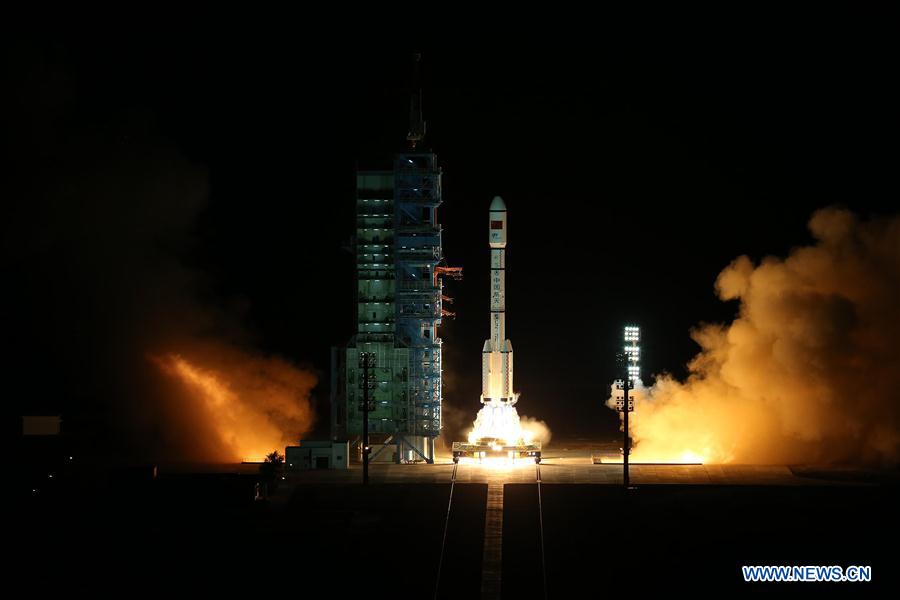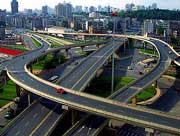

 |
| China's space lab Tiangong-2 roars into the air on the back of a Long March-2F rocket from the Jiuquan Satellite Launch Center in northwest China, Sept. 15, 2016. (Xinhua/Ju Zhenhua) |
BEIJING, Sept. 16 (Xinhua) -- China on Thursday hurled its first Tiangong-2 lab into space, marking another step forward in the country's plans to establish a permanent station by the early 2020s.
China's rapid development in space exploration within the past decade has impressed the world. Martin Barstow, director of Leicester Institute of Space & Earth Observation at the University of Leicester, told Xinhua in a recent interview that China's developing space program is another major milestone towards establishing a permanent presence in space.
"The earlier success of the first space station (Tiangong-1) shows how the program is developing and the new space laboratory will continue to add to China's status as a major space power," the professor said.
Former NASA astronaut Leroy Chiao, the first Chinese-American to be commander of the International Space Station, hailed Tiangong-2 as "another significant step for China's human spaceflight program."
"China is moving in a very deliberate and orderly fashion to advance their space capability," Chiao said. "I think the technology is good, and they are moving to get more operational experience through TG-2, before the beginning of space station construction."
Barstow also spoke highly of China's space capability, saying "China is already a key player in the international space industry," and Tiangong-2 will "enhance" its well-developed space capability.
Gao Yang, director of Surrey Technology for Autonomous Systems and Robotics (STAR) Lab, said manned spaceflight is of indicative significance in space technology, and China's rapid development in this area is well-known.
British Broadcasting Corporation (BBC) said in an article published on Thursday that "Beijing has made space exploration a national priority and is the third country, after the Soviet Union and the U.S., to put astronauts into space."
INTERNATIONAL COOPERATION NEEDED
In different interviews Xinhua carried with space experts, all mentioned the need for international cooperation in space exploration. Space station programs have always been a cradle for countries to work together, Gao said.
Such collaboration has been vividly reflected in the Tiangong-2 mission, which carries, among a number of scientific experiments, an astrophysics detector that is the first space-science experiment built jointly by China with European countries.
POLAR, dedicated to establishing whether the photons from Gama ray bursts (GRBs) -- thought to be a particularly energetic type of stellar explosion -- are polarized, was built largely with Swiss funding, and with the collaboration of Swiss, China and Polish scientists and support from the European Space Agency (ESA), according to the British journal Nature.
POLAR project manager Nicolas Produit, who spoke to Nature, said U.S. law bars NASA from doing joint projects with China's space agencies, but the Chinese Academy of Sciences is discussing a number of other collaborative space projects with the ESA.
Gregory Kulacki, senior analyst and China project manager at the U.S.-based Union of Concerned Scientists' Global Security Program, said that it is encouraging that China intends to solicit international participation in its space station project.
"My hope is that the United States and China will, at an appropriate time in the future, find a way to cooperate in the peaceful exploration of space instead of competing to turn it into a battlefield, as they are now," he said.
Chiao said international coperation is "a common point of interest that helps improve overall relationships. The International Space Station is a great example of that. Many nations came together to build the amazing facility, and we are working together to further science. This helps to improve overall relations between the member countries."
Barstow believed that more and more countries are seeing the importance of space activity but this will not turn into a race. He said that to benefit smaller economies, a growth of space activity across the world will need to be nurtured by the major agencies like ESA, NASA, the Russian Federal Space Agency (Roscomos) and China National Space Administration (CNSA).
CHINA'S AMBITIOUS SPACE PROGRAM
China has been actively developing a three-step manned space program since the first decade of the 21st century.
The program's first mission took place in 1999 with the launch of the Shenzhou-1 to examine the performance and reliability of the launcher and verify key technologies relating to capsule connection and separation, heat prevention, control and landing.
The first step, to send an astronaut into space and return safely, was fulfilled by Yang Liwei in the Shenzhou-5 mission in 2003.
The second step was developing advanced space flight techniques and technologies including extra-vehicular activity and orbital docking. This phase also includes the launch of two space laboratories -- effectively mini space-stations that can be manned on a temporary basis.
The next step will be to assemble and operate a permanent manned space station.
China will begin building a space station that is more economically efficient and uses more data than the current International Space Station (ISS), starting as early as 2017, chief engineer of China's manned space program Zhou Jianping told Xinhua on Thursday.
With the ISS set to retire in 2024, the Chinese space station will offer a promising alternative, and it will make China the only country to have a permanent space station after the ISS.
Day|Week

 Who Will Fit The Chinese Roles In Game Of Thrones?
Who Will Fit The Chinese Roles In Game Of Thrones? China's Hubei Shennongjia added to World Heritage List
China's Hubei Shennongjia added to World Heritage List Cute Dog At Fruit Stand Becomes Latest Internet Sensation
Cute Dog At Fruit Stand Becomes Latest Internet Sensation Top 10 livable Chinese cities
Top 10 livable Chinese cities The last primitive tribe in China
The last primitive tribe in China China's first intelligent security robot debuts in Chongqing
China's first intelligent security robot debuts in Chongqing A Total of 3,552 Subscribers Vanish In Two Days; YouTube Closes All Doors to Users’ Inquiries
A Total of 3,552 Subscribers Vanish In Two Days; YouTube Closes All Doors to Users’ Inquiries Out of this world! Futuristic UFO-shaped yacht has its own garden and a stunning underwater viewing deck
Out of this world! Futuristic UFO-shaped yacht has its own garden and a stunning underwater viewing deck An old tea house in Chengdu
An old tea house in Chengdu Furious Customer Crushes All the Buns from Vendor Just Because He Was Given the Wrong Flavor
Furious Customer Crushes All the Buns from Vendor Just Because He Was Given the Wrong Flavor